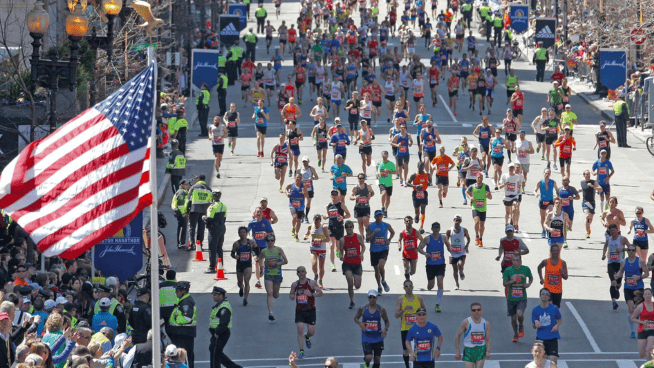Functional Movement Training for Football
Functional movement training has garnered lots of publicity over the past few years. Since strength and conditioning was first introduced about 30 years ago, training has evolved dramatically. We are in an exciting time, where specificity of training has led to great improvements in sport performance. Not too long ago, a 40-Yard Dash time of 4.7 seconds for a wide receiver was considered exceptional. Today, athletes are posting times under 4.3 seconds!
Used properly, functional movement training can be the difference between becoming a good athlete and an exceptional one. The premise of this type of training is to train movement, not muscles. For example, for football players, a Front Squat would be considered a functional movement exercise, whereas Leg Extensions would not. Both exercises increase your quad strength, but only one—the Front Squat—trains your muscles while you are standing and supporting yourself like you do on the football field. It also strengthens other muscles, like the core and glutes, which are important for sprinting and tackling. On the other hand, Leg Extensions (from a seated position) are not considered functional because they do not match the biomechanics of any movement you perform on the field.
Unfortunately, like all good things, functional movement training is often taken out of context and poorly executed. To further define functional movement training and learn how to apply it to a workout program, let’s examine what functional movement training is and what it is not.
Functional movement training is . . .
. . . the ability to produce and maintain a balance between mobility and stability along the kinetic chain while performing fundamental patterns.[5]
Any time you lack the proper mobility and stability combination for your sport, your efficiency goes down and you risk decreased performance and increased chance of injury. These are referred to as energy leaks. To perform your best, you need to have all of your energy going towards the task at hand, not dispersed into never-never land.
Think of it this way: To run 100 yards, would you be faster running in a straight line or running in a zig-zag pattern? Running in a straight line, your body will be performing optimally. Running left and right, you will have “energy leaks.”
Functional movement training is not . . .
. . . using exercises deemed functional in an inappropriate way.
For example, a local CrossFit coach asked my football team to take part in what he termed a “biomechanical challenge,” which included timed Handstand Holds. Yes, Handstand Holds engage the core, and core strength is applicable to sprinting. However, they are certainly not applicable to football.
Functional movement training is . . .
. . . matching biomechanics and musculature used in movements specific to the sport and engaging energy systems required for the sport.
For example, a football player training to increase his sprinting strength and power should look to Weighted Sled Sprints.
Functional movement training is not . . .
. . . performing sports movements with so much weight that your biomechanics change.
For example, a football player doing Weighted Sled Sprints with too much load is counterproductive. It alters his running biomechanics and develops an unnecessary motor pathway, which could lead to performance deterioration.[1,2,6]
Sled Drives are an example of a functional movement training exercise that increases your force and explosiveness, but you need to use the right load to maintain proper running biomechanics.
Functional movement training is . . .
. . . recruiting the correct muscles, coordinating firing patterns and generating greater force for better speed, acceleration and power.[6]
A good example would be performing Power Cleans at a load of 70-80% 1RM as fast and explosively as possible for a set of 1-4 repetitions.
Functional movement training is not . . .
. . . recruiting the correct muscles and coordinating firing patterns in an inappropriate way to generate greater speed, acceleration and power.
Doing a set of 30 Power Cleans does not translate to greater force, speed, and power. This is an example of improperly using an exercise designed for power as an aerobic conditioning tool.
Functional movement training is . . .
. . . adding tools with the right purpose and at the right time.
For example, a Knee Tuck or Pike with the stability ball, TRX, or ab wheel are effective exercises for activating the core.[3] These types of movements require core stability similar to sprinting, cutting, and tackling.
Functional movement training is not . . .
. . . adding unnecessary tools or using tools in an unnecessary way.
Some trainers of football athletes recommend standing on a BOSU ball, because it develops greater balance and stability.[6] But how often do you stand on unstable ground in football?
Summary
Functional movement training can increase your efficiency, improve your movement patterns and enhance your biomechanics when used appropriately. When used inappropriately, it can inhibit your performance and even increase your risk of injury. By choosing the best equipment and exercises at the right time, football players can get a greater benefit from training and have more success on the field.
Learn more about functional training through these articles:
- The Real Definition of Functional Training
- Functional Sports Training
- Crash Conditioning’s Functional Training
References
[1] Baggett, K. The Ultimate No-Bull Speed Development Manual. Hollister, Mo 2006, pp. 6-7. [2] Buchenholz, D., The Best Sports Training Book Ever: Modality Principles. Inno-Sport Publishing Group, 2003, p. 39 [3] Escamilla, R. F., Lewis, C., Bell, D., Bramblet, G., Daffron, J., Lambert, S., Pecson, A., Imamura, R., Paulos, L., & Andrews, J. R. (2010). “Core muscle activation during swiss ball and traditional abdominal exercises.” Journal of Orthopadaedic & Sports Physical Therpay, 40(5), 265276. [4] Magill, R. A. (2011). Motor learning and control: Concepts and applications (9th ed.). New York: McGraw-Hill. [6] Maglischo, E., Maglischo, C., Zier, D., Santos, T. “The Effects of Sprint-Assisted and Sprint-Resisted Swimming on Stroke Mechanics.” Journal of Swimming Research, 1, Pp27-33; 1985. [7] Okada, T., Huxel, K. C., & Nesser, T. W. (2011). “Relationship between core stability, functional movement, and performance.” Journal of Strength and Conditioning Research, 25(1),252-261.RECOMMENDED FOR YOU
MOST POPULAR
Functional Movement Training for Football
Functional movement training has garnered lots of publicity over the past few years. Since strength and conditioning was first introduced about 30 years ago, training has evolved dramatically. We are in an exciting time, where specificity of training has led to great improvements in sport performance. Not too long ago, a 40-Yard Dash time of 4.7 seconds for a wide receiver was considered exceptional. Today, athletes are posting times under 4.3 seconds!
Used properly, functional movement training can be the difference between becoming a good athlete and an exceptional one. The premise of this type of training is to train movement, not muscles. For example, for football players, a Front Squat would be considered a functional movement exercise, whereas Leg Extensions would not. Both exercises increase your quad strength, but only one—the Front Squat—trains your muscles while you are standing and supporting yourself like you do on the football field. It also strengthens other muscles, like the core and glutes, which are important for sprinting and tackling. On the other hand, Leg Extensions (from a seated position) are not considered functional because they do not match the biomechanics of any movement you perform on the field.
Unfortunately, like all good things, functional movement training is often taken out of context and poorly executed. To further define functional movement training and learn how to apply it to a workout program, let’s examine what functional movement training is and what it is not.
Functional movement training is . . .
. . . the ability to produce and maintain a balance between mobility and stability along the kinetic chain while performing fundamental patterns.[5]
Any time you lack the proper mobility and stability combination for your sport, your efficiency goes down and you risk decreased performance and increased chance of injury. These are referred to as energy leaks. To perform your best, you need to have all of your energy going towards the task at hand, not dispersed into never-never land.
Think of it this way: To run 100 yards, would you be faster running in a straight line or running in a zig-zag pattern? Running in a straight line, your body will be performing optimally. Running left and right, you will have “energy leaks.”
Functional movement training is not . . .
. . . using exercises deemed functional in an inappropriate way.
For example, a local CrossFit coach asked my football team to take part in what he termed a “biomechanical challenge,” which included timed Handstand Holds. Yes, Handstand Holds engage the core, and core strength is applicable to sprinting. However, they are certainly not applicable to football.
Functional movement training is . . .
. . . matching biomechanics and musculature used in movements specific to the sport and engaging energy systems required for the sport.
For example, a football player training to increase his sprinting strength and power should look to Weighted Sled Sprints.
Functional movement training is not . . .
. . . performing sports movements with so much weight that your biomechanics change.
For example, a football player doing Weighted Sled Sprints with too much load is counterproductive. It alters his running biomechanics and develops an unnecessary motor pathway, which could lead to performance deterioration.[1,2,6]
Sled Drives are an example of a functional movement training exercise that increases your force and explosiveness, but you need to use the right load to maintain proper running biomechanics.
Functional movement training is . . .
. . . recruiting the correct muscles, coordinating firing patterns and generating greater force for better speed, acceleration and power.[6]
A good example would be performing Power Cleans at a load of 70-80% 1RM as fast and explosively as possible for a set of 1-4 repetitions.
Functional movement training is not . . .
. . . recruiting the correct muscles and coordinating firing patterns in an inappropriate way to generate greater speed, acceleration and power.
Doing a set of 30 Power Cleans does not translate to greater force, speed, and power. This is an example of improperly using an exercise designed for power as an aerobic conditioning tool.
Functional movement training is . . .
. . . adding tools with the right purpose and at the right time.
For example, a Knee Tuck or Pike with the stability ball, TRX, or ab wheel are effective exercises for activating the core.[3] These types of movements require core stability similar to sprinting, cutting, and tackling.
Functional movement training is not . . .
. . . adding unnecessary tools or using tools in an unnecessary way.
Some trainers of football athletes recommend standing on a BOSU ball, because it develops greater balance and stability.[6] But how often do you stand on unstable ground in football?
Summary
Functional movement training can increase your efficiency, improve your movement patterns and enhance your biomechanics when used appropriately. When used inappropriately, it can inhibit your performance and even increase your risk of injury. By choosing the best equipment and exercises at the right time, football players can get a greater benefit from training and have more success on the field.
Learn more about functional training through these articles:
- The Real Definition of Functional Training
- Functional Sports Training
- Crash Conditioning’s Functional Training
References
[1] Baggett, K. The Ultimate No-Bull Speed Development Manual. Hollister, Mo 2006, pp. 6-7. [2] Buchenholz, D., The Best Sports Training Book Ever: Modality Principles. Inno-Sport Publishing Group, 2003, p. 39 [3] Escamilla, R. F., Lewis, C., Bell, D., Bramblet, G., Daffron, J., Lambert, S., Pecson, A., Imamura, R., Paulos, L., & Andrews, J. R. (2010). “Core muscle activation during swiss ball and traditional abdominal exercises.” Journal of Orthopadaedic & Sports Physical Therpay, 40(5), 265276. [4] Magill, R. A. (2011). Motor learning and control: Concepts and applications (9th ed.). New York: McGraw-Hill. [6] Maglischo, E., Maglischo, C., Zier, D., Santos, T. “The Effects of Sprint-Assisted and Sprint-Resisted Swimming on Stroke Mechanics.” Journal of Swimming Research, 1, Pp27-33; 1985. [7] Okada, T., Huxel, K. C., & Nesser, T. W. (2011). “Relationship between core stability, functional movement, and performance.” Journal of Strength and Conditioning Research, 25(1),252-261. [8] Shea, J. Specificity of training. Retrieved online 06/20/13.











